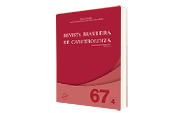Positive Relation between Standardized Phase Angle and Clinical Neoplasm Staging in Individuals with Cancer
DOI:
https://doi.org/10.32635/2176-9745.RBC.2021v67n4.1513Keywords:
Neoplasms, Neoplasm Staging, Electric Impedance, Nutritional StatusAbstract
Introduction: Cancer is characterized by the abnormal growth of cells in a tissue, with the potential to invade another organs and tissues. The knowledge of the anatomical extent of cancer and its infiltration capacity are important to guide therapies and prognosis, and the evolution of this disease has severe negative impact on the patient’s nutritional status. Phase angle (PA) is an excellent prognostic tool for this group. Objective: To associate the standardized phase angle (SPA) with clinical staging in cancer patients. Method: Observational and cross-sectional study with adults and older adults with cancer non-hospitalized. Clinical information and clinical staging (TNM) of cancer were obtained from electronic charts. Patient-Generated Subjective Global Assessment (PG-SGA) was performed, and the PA was calculated using values collected by bioimpedance and then the standardized PA (SPA). Results: 25 volunteers participated, with mean age of 58.3 years (±13.7), 54.8% females and 54.8% older adults. The most frequent tumor site was in the stomach (36%), 44% of the participants were in clinical stages II and 56%, III or IV. According to the PG-SGA, 74% of the volunteers had some degree of nutritional impairment (score B or C), and a positive association was detected between SPA and tumor staging (p>0.0414). Conclusion: SPA was positively related to clinical staging in individuals with cancer.









